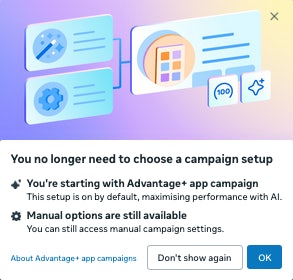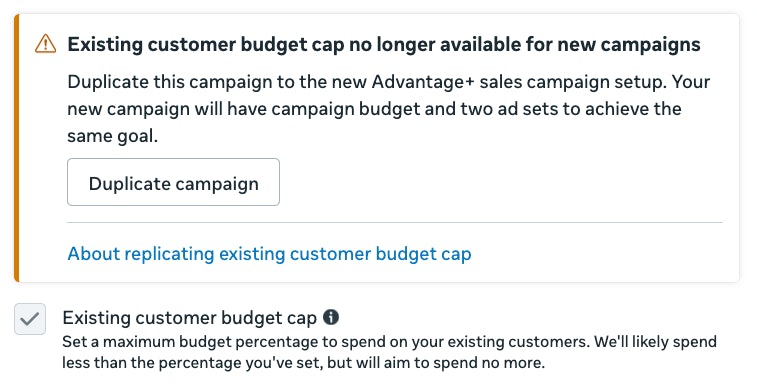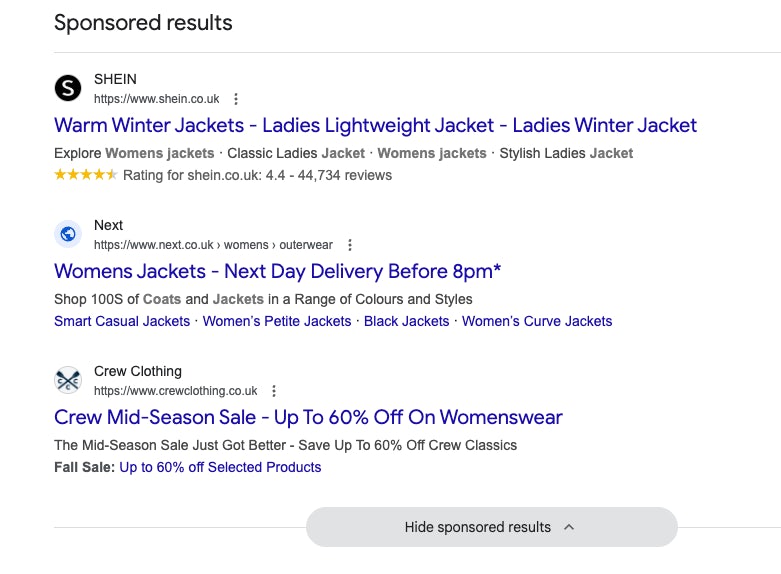The clocks may have rolled back, but the Paid Media landscape keeps running forward! With the cold of Autumn setting in, there are a few October updates to keep every advertiser’s heart warm…
Read on to learn more about:
- Conversions can come directly to ChatGPT
- Meta now uses data from its AI to target ads
- Meta ASC and AAC campaigns are being deprecated
- Call-Only Google Ads are being deprecated
- Google launches new features to integrate App and Web advertising
- Subscription Ads launched on Google
- Users can hide sponsored results in Google SERPs
- Pinterest introduces new ad solutions
- Other minor changes
- Meta Value Rules continue updating
- Source column added to AI Max Search reporting
- Meta Catalogue campaigns not accepting ad set level changes
Conversions can come directly to ChatGPT
You can now ask the chatbot to buy a product for you, and it will directly handle the transaction with the seller – just like your very own personal shopper.
This feature has been in the plans for a while, with reporting on it coming since July this year, and what we’re seeing now is definitely not (yet) the final version. But this initial public launch shows us the direction of Shopping in ChatGPT and it’s worth paying attention to. Direct shopping is still only available through Etsy in the USA, and it only allows you to buy one product at a time. Integrations for multi-item shopping carts are coming soon, and OpenAI is working on expanding the regions and platforms that this is available to.
It’s still unclear how users respond to this feature, but uptake can be expected to increase as more vendors and better integrations become available. Etsy sellers have shared mixed feelings about this launch, with hesitations around AI making mistakes, and reducing the on-site traffic that the sellers would usually get. Sales through ChatGPT also require an extra fee from the seller, and the exact price is not yet clear. But the benefits of this new feature speak for themselves: quicker sales for very niche interests that would be very difficult to cater to through traditional search engines and advertising.
What this means for you
If your business has a shop with a supported partner, you should make sure that your pages are crawlable by AI agents, and that your product images are absolutely clear as this is the only thing shown directly to the user without being changed by the AI. If your store is not yet supported, you may see a decrease in traffic from ChatGPT as buyers opt for in-platform purchases through competitors rather than visiting your website.
While ads within ChatGPT haven’t launched quite yet, this new monetisation method shows that the platform is moving towards a more commerce-focused future. Keep your eyes peeled for further updates to come.
Meta now uses data from its AI to target ads
As always, interactions within Meta’s platforms are used to categorise users into different demographics and interest categories. Conversations with Meta’s AI could not, up until now, be used to improve the user targeting. This new feature means that conversations with AI will now produce data to help further personalise what kind of content (and ads) users will be served.
Users started being notified of this change on October 6th, before it goes fully into effect on December 16th.
What this means for you
This new source of data will help keep accounts properly categorised so that your targeting reaches the right audience. As it is collected on-site by Meta, this data is likely to keep getting collected and to keep getting more precise, which is increasingly important as regulatory concerns continue to restrict off-site data collection.
Meta ASC and AAC campaigns are being deprecated
Advantage Shopping Campaigns (ASC) and Advantage App Campaigns (AAC) can no longer be created. ASC and AAC campaign were already on the way out, but Meta will no longer support their creation through external APIs, which was possible until this month. Instead, these campaign types will be rolled into the existing Advantage+ campaign type.
ASC and AAC campaign types were launched in 2022 as a way to integrate more automation into campaign creation and optimisation. As Advantage+ features have grown and become more integrated across the entirety of Meta Ads, this move away from specialist campaign types is meant to streamline and add flexibility for advertisers.
What this means for you
Your ASC and AAC campaigns should automatically update to this new campaign type when you next edit them, with a few exceptions:
- The “Existing customer budget cap” feature will no longer be available. If your campaign uses this setting, your campaign won’t automatically update and you’ll have to manually copy it over instead.
- If your campaign has more than 50 ads, it won’t be automatically updated, as the new Advantage+ set-up only supports up to 50 ads per adset. You can manually migrate it within the Ads manager.


Call-Only Google Ads are being deprecated
Call Ads on Google are being phased out, and replaced with Call assets within Responsive Search Ads (RSAs).
Starting in February 2026, you will no longer be able to create new Call Ads. A year later in February 2027, any remaining Call Ads will stop generating Impressions.
What this means for you
Google has created a guide on how to transition from Call Ads campaigns to RSA campaigns with call assets. If you want to continue drawing direct calls from your ads, you will need to set your account up to properly run RSA campaigns, ensuring that you’re adding your phone number(s) as assets.
If your business relies strongly on direct phone calls, you may see a decrease in these as other ad assets get pulled through instead of just your phone number. As purchase journeys change and audiences increasingly prefer having more options on how to interact with businesses, this may be a good time to re-think what success looks like for your ad campaigns.
Google launches new features to integrate App and Web advertising
As user journeys continue becoming more complex, Google is further integrating Web and App advertising.
In order to make it easier for you to run and manage the customer experience across multiple touchpoints, the following features have recently been introduced…
- Web to App connect is expanding to YouTube ads. You can now get users from YouTube directly to your app using a variety of campaign types. This new feature is available for both iOS and Android.
- Reporting across App and Web has just become easier, as Google now automatically bundles in-app events with their web equivalents.
- There is now a Combined Overview card available in your Google Ads homepage, where you can see a comparison between your App and Web performance.
- You can now see data for App Installs in your web campaigns, giving you greater visibility of all the steps in the conversion funnel, and how your web campaigns are contributing to in-app conversions.
What this means for you
If you are running ads to your App, these updates will make this activity easier to run, report and optimise.
Subscription Ads launched on Google
Shopping Ads are a Google solution for promoting your products. By pulling product data directly from your Merchant Centre, this type of ad is very useful for moving inventory. However, as more and more businesses rely on subscription models to keep consistent revenue coming in month after month, this campaign type’s limitation to only instantly available products has been a blocker – until now!
Google has officially launched subscription ads for physical products.
This is currently only available in the USA with some severe limitations. Only products from a limited list are eligible at the moment, and ad landing pages must only show one subscription option, limiting flexibility for advertisers. Price changes such as discounts or introductory pricing are not available quite yet either.
What this means for you
If you want to promote subscriptions for
- Apparel and accessories,
- Coffee,
- Healthcare (excluding prescription drugs),
- Home and garden,
- Personal care,
- Pet supplies,
- Prepared foods,
- or Toys,
you can now leverage Google Shopping Ads to do so. While the current limitations of this campaign type are quite strict, we expect them to ease as Google continues to build functionality.
Users can hide sponsored results in Google SERPs
Google has added a new UI element on Search pages. From now on, advertisements on Search will be shown to users between a “Sponsored Results” sticky header, and a “Hide sponsored results” button. The header element will stay at the top of the page until the user has scrolled fully through all advertisements. Once the user has scrolled past all advertisements, they can opt to hide them, which will collapse the section leaving only the header and button.
This change is meant to visually separate Organic and Paid results, as users and regulators look for more transparency in ad labelling.

What this means for you
Because users are still required to see all Sponsored Results before being allowed to collapse them, this update is unlikely to change performance for either Paid or Organic results. Continue monitoring performance as this feature rolls out more broadly.
Pinterest introduces new ad solutions
Pinterest Presents has recently happened and, with it, a few new advertiser-focused features have come to light!
With the recent launch of Top Of Search ads, Pinterest is giving advertisers the best chance of gathering interested clicks from non-branded searches on the platform. By showing your pins and products before organic results (instead of intermixed with them), this type of ad immediately gets your brand in front of the people looking for solutions like yours.
With this focus on conversions, Pinterest has also launched Local Inventory ads. These let users view product prices and what’s in stock in stores near them. This is a good way to drive in-store traffic and purchases, and shows Pinterest’s interest in being a more prominent player on users’ purchase journeys.
To help advertisers get the best data for their campaigns, they’ve also made it easier to integrate first party data into the platform through a new self-service tool called Pinterest Media Network Connect. This is available through the Ads Manager as a self-service tool.
What this means for you
These new features make it easier to get started and may give more immediate results than traditional Pinterest ads have in the past. As the offering for advertisers on Pinterest continues to increase, it may be time for more advertisers to start experimenting with the platform!
Other minor changes
Meta Value Rules continue updating
A few months ago, Meta made changes to campaign optimisation options based on the value of conversions. A new option to adjust bid based on the platform the user is on (mobile vs desktop) was added this month, showing that Meta is continuing to prioritise these bidding control options as broad audiences continue to play a more important role on the platform.
Source column added to AI Max Search reporting
You can now see the Source for AI Max search, between landing pages, URL Inclusions or AI Max Expanded Searches. This new metric will help advertisers ensure that the content created and matched by Google’s automation is correct and reaching the right people.
Meta Catalogue campaigns not accepting ad set level changes
Having multiple different catalogues on a single Catalogue campaign is no longer accepted. While this may reduce the chance of errors due to automatic selections, it further reduces flexibility for advertisers.
Look out for our November edition of “What’s New in Paid Media” for a monthly round-up of industry updates to inspire your PPC, Paid Social, and Programmatic strategy. If you want to talk about your business’s aspirations, get in touch!






